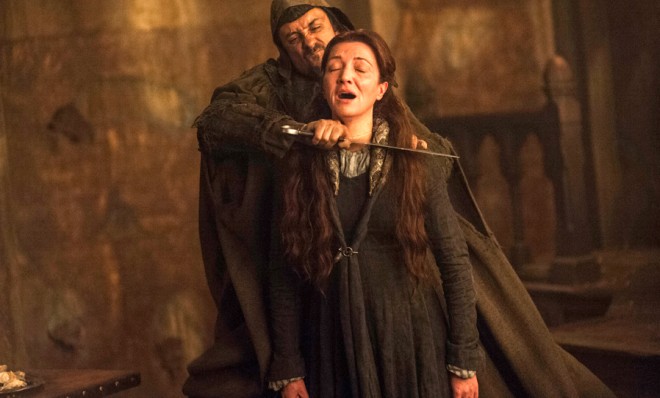The real-life events that inspired Game of Thrones' Red Wedding
It all started with two very dark events in Scottish history


As shocking as Sunday's Starkicide was, what's even more shocking is that events like these actually happened. Author George R.R. Martin has said that the inspiration for the betrayal is based on two dark events in Scottish history: the Black Dinner of 1440 and the Massacre of Glencoe from 1692. "No matter how much I make up, there's stuff in history that's just as bad, or worse," Martin has said. And he's absolutely right. See for yourself.
THE MASSACRE OF GLENCOE
In 1691, all Scottish clans were called upon to renounce the deposed King of Scotland, James VII, and swear allegiance to King William of Orange (of William and Mary fame). The chief of each clan had until January 1, 1692, to provide a signed document swearing an oath to William. The Highland Clan MacDonald had two things working against them here. First of all, the Secretary of State, John Dalrymple, was a Lowlander who loathed Clan MacDonald. Secondly, Clan MacDonald had already sworn an oath to James VII and had to wait on him to send word that they were free to break that oath.
The Week
Escape your echo chamber. Get the facts behind the news, plus analysis from multiple perspectives.

Sign up for The Week's Free Newsletters
From our morning news briefing to a weekly Good News Newsletter, get the best of The Week delivered directly to your inbox.
From our morning news briefing to a weekly Good News Newsletter, get the best of The Week delivered directly to your inbox.
Unfortunately, it was December 28 before a messenger arrived with this all-important letter from the former king. That gave Maclain, the chief of the MacDonald clan, just three days to get the newly-signed oath to the Secretary of State.
Maclain was detained for days when he went through Inveraray, the town of the rival Clan Campbell, but still managed to deliver the oath, albeit several days late. The Secretary of State's legal team wasn't interested in late documents. They rejected the MacDonalds' sworn allegiance to William, and set plans in place to cut the clan down, "root and branch."
In late January or early February, 120 men under the command of Captain Robert Campbell arrived at the MacDonalds' in Glencoe, claiming to need shelter because a nearby fort was full. The MacDonalds offered their hospitality, as was custom, and the soldiers stayed there for nearly two weeks before Captain Drummond arrived with instructions to "put all to the sword under seventy."
After playing cards with their victims and wishing them goodnight, the soldiers waited until the MacDonalds were asleep, then murdered as many men as they could manage — 38 in all, some still in their beds. At least 40 women and children escaped, but fleeing into a blizzard blowing outside as their houses burned down meant that they all died of exposure.
A free daily email with the biggest news stories of the day – and the best features from TheWeek.com
The massacre was considered especially awful because it was "Slaughter Under Trust" — sound familiar, Game of Thrones fans? To this day, the door at Clachaig Inn in Glen Coe has a sign on the door denying entry to Campbells.
THE BLACK DINNER
In November of 1440, the newly-appointed 6th Earl of Douglas, who was just 16, and his little brother David, were invited to join the 10-year-old King of England Scotland, James II, for dinner at Edinburgh Castle. But it wasn't the young King who had invited the Douglas brothers. The invitation had been issued by Sir William Crichton, Chancellor of Scotland, who feared that the Black Douglas (there was another clan called the Red Douglas) were growing too powerful.
As legend has it, the children were all getting along marvelously, enjoying food, entertainment and talking until the end of the dinner, when the head of a black bull was dropped on the table, symbolizing the death of the Black Douglas. The two young Douglases were dragged outside, given a mock trial, found guilty of high treason, and beheaded. It's said that the Earl pleaded for his brother to be killed first so that the younger boy wouldn't have to witness his older brother's beheading.
Sir Walter Scott wrote this of the horrific event:
"Edinburgh Castle, toune and towre,God grant thou sink for sin!And that e'en for the black dinnerEarl Douglas gat therein."
More from Mental Floss:
-
 Why it’s important to shop around for a mortgage and what to look for
Why it’s important to shop around for a mortgage and what to look forThe Explainer You can save big by comparing different mortgage offers
-
 4 ways to save on rising health care costs
4 ways to save on rising health care costsThe Explainer Health care expenses are part of an overall increase in the cost of living for Americans
-
 How to financially prepare for divorce
How to financially prepare for divorceThe Explainer Facing ‘irreconcilable differences’ does not have to be financially devastating